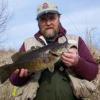Every year, I spend two weeks on the same Northern Wisconsin lake chasing pre-spawn, smallmouth and largemouth bass. I've been taking the last two weeks of May for this trip, but the last few years, the weather for the first week of the trip has been horrible. Last year, in addition to the cold temps, it rained 5 out of the first 7 days. In the two years prior to that, the ice had only gone out days before our arrival and we had two days with snow. To up my odds, this year, we booked our stay a week later than normal. That was a good decision as the ice left the lake around May 7th about a month later than the average date. Winter turned quickly into summer and the temps from the beginning of May were consistently in the 70's and low 80's, very warm for that area during May. Warm, sunny days with light winds followed and the fishing the first week was very good. The lake I fish isn't a trophy lake but a HUGE numbers lake which is the way I like it. The water temps rose quickly from the low 50's to the low 60's by the end of the first week.
The pattern of fish movement on this lake I have witnessed over the last 20 years during the spring is that when the water temp hits 50, the smallies will move onto the many offshore rock bars and often will concentrate there in schools. At times, we can catch 50 or more bass in one spot without moving the boat. As the water warms, the fish we catch on these bars begin to get smaller as the larger bass will move to their spawning areas and spread out along the shorelines. When the water gets near 60, spawning beds will begin to appear. At first, you just see beds with no fish on them. As days pass and the water temps rise, there are more beds and the bass are closer to them. At this point they are still feeding pretty well and will readily take baits that are cast near them. In may areas, the beds are so numerous and close together, we call them "Bozo Buckets" (Remember Bozo's Circus on TV?) Once they lock onto the beds, the feeding stops and the good fishing ends. My fishing partners and I don't enjoy harassing bedding fish that aren't still feeding so we leave them alone at that time.
This year, the offshore fish never really stacked up. The bigger fish seldom appeared anywhere. During the second week of my trip, the air temps which normally average 69, were near 90 every day. The water went from the low 60's to 70 very quickly. During a normal season. It takes 2 full months to go from ice to 70 degrees. This year, it did it in 3 weeks. During this past week, we expected the beds to appear and the bass to be along the shorelines but few beds were made any only one out of 5 had a fish anywhere near it. For those of you who believe bass spawn during the full moon, it came and went with nothing happening. With water temps at 70, the smallmouth bass should be done spawning but as of now, it hasn't even started. I'm always gone by the time the largemouth spawn. But even they aren't making many beds yet. I won't be up there to see what's going to happen, but for this year, it looks like the bass for the most part, won't spawn at all. It's been a very unusual year. I keep track of the number of fish I catch and the numbers were close if not better than most years, probably because the water was much warmer than usual, but the average size was down considerably.
One strange thing happened. I was fishing the edge of a rock pile and hooked a big fish. As it came near the boat, I could see it was a very large walleye. I turned my head to tell my partner to get the net. When I looked back, the walleye was gone and a small smallmouth was on the line in it's place! The only thing I figure could have happened was that the walleye grabbed the smallmouth right after I hooked it. when I was bringing it in, I couldn't see the bass. The walleye must have let the bass go right next to the boat. That had me scratching my head for a while.









